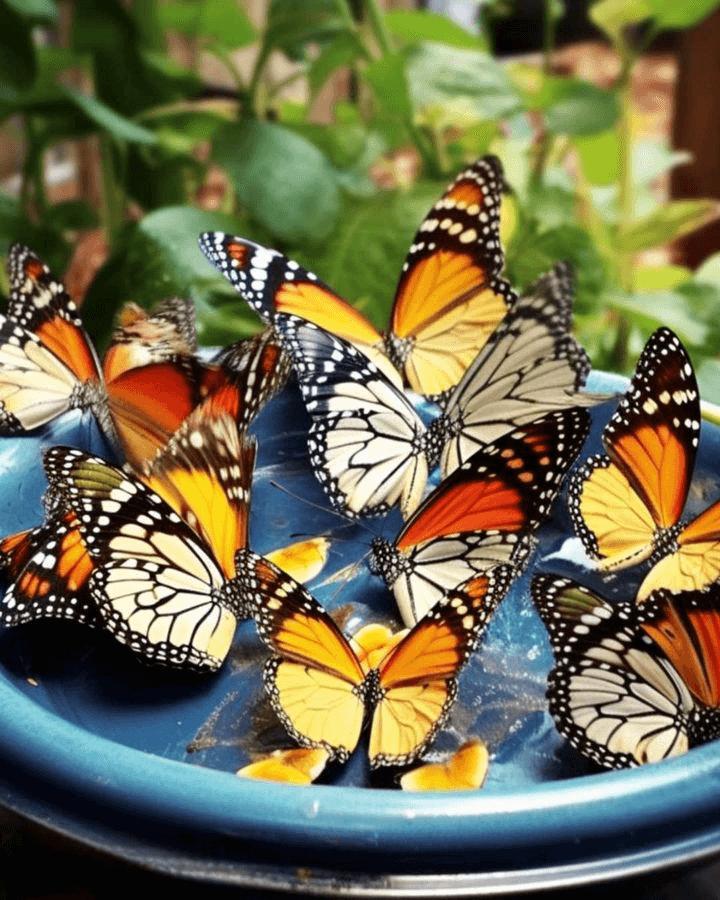Butterflies add a magical touch to gardens and are vital for pollination. Making your own butterfly feeder is an easy and enjoyable way to invite these graceful pollinators into your outdoor space. Here are seven simple DIY butterfly feeder ideas that are both practical and decorative.
1. Fruit Slice Feeder
Use ripe fruits like bananas, oranges, or strawberries. Slice the fruit and thread it onto string or twine, then hang it in your garden.
Why It Works: Butterflies are naturally drawn to the sugar in ripe fruit. Their color and fragrance help attract butterflies easily. This low-effort design is perfect for beginners and is easy to refresh as needed.
2. Mason Jar Nectar Feeder
Fill a mason jar with a sugar-water mixture and insert a sponge or sponge cloth inside to serve as a wick. Hang the jar with wire or twine.
Why It Works: The sponge gives butterflies a landing pad while providing access to the nectar. This setup allows you to check nectar levels and refill with ease. Its elevated design mimics natural nectar sources like flowers.
3. Plate and Wine Cork Feeder
Place sugar water on a small plate and glue wine cork slices around the edge for perching.
Why It Works: The corks serve as convenient landing spots. The sugar water is easily visible, drawing in butterflies. This creative design adds flair to any garden.
4. Popsicle Stick Feeder
Glue popsicle sticks together to form a platform with small gaps. Hang it using string or pipe cleaners, and place fruit slices or mashed bananas on top.
Why It Works: The feeder offers multiple perches and angles for feeding. Popsicle sticks are affordable and easy to work with, and the combination of textures entices butterflies.
5. Sponge and Saucer Feeder
Cut a kitchen sponge to size and place it in a shallow saucer filled with sugar water. Hang it using string or wire.
Why It Works: The sponge provides a stable surface for butterflies to land and feed. The larger feeding area appeals to more butterflies at once and is simple and cost-effective to make.
6. Flower Pot Feeder
Insert artificial flowers with nectar-soaked centers into a small flower pot placed on a saucer of sugar water.
Why It Works: The faux flowers imitate real blooms, drawing butterflies with their shape and color. This feeder doubles as a decorative addition to your garden.
7. Orange Peel Cup Feeder
Halve an orange, scoop out the pulp, and use the peel as a cup for sugar water. Hang it with string or wire.
Why It Works: The orange peel maintains its natural scent and color, making it highly attractive. Its cup shape creates a safe resting place for butterflies as they feed.
How to Create a Butterfly-Friendly Garden
Besides feeders, creating a suitable environment will keep butterflies returning:
Grow Nectar Plants: Include flowering plants like milkweed, zinnias, lavender, lantana, verbena, coneflowers, and butterfly bush.
Add Host Plants: Caterpillars need specific host plants to feed on. For example, monarchs need milkweed. Research local butterfly species and grow the right plants to support their lifecycle.
Provide Sun: Butterflies use the sun to regulate body temperature. Design your garden with sunny spots for basking.
Create Shelter: Use shrubs, tall grasses, and rocks to give butterflies protection from predators and wind.
Avoid Pesticides: Chemicals harm butterflies and caterpillars. Choose natural pest control methods instead.
Offer Water Sources: Butterflies enjoy “puddling” for minerals. Provide shallow dishes of water with soil or sand for them to rest and drink.
Add Colorful Flowers: Bright blooms in red, yellow, orange, and purple are particularly attractive to butterflies.
Ensure Continuous Blooming: Plant flowers with staggered blooming times to provide nectar throughout the seasons.
Group Plants Together: Clustering plants helps butterflies easily locate nectar and reduces energy spent flying between food sources.
Use Organic Fertilizer: Chemical fertilizers can damage both butterflies and their host plants. Opt for eco-friendly alternatives.
Block the Wind: Butterflies struggle in windy areas. Plant windbreaks or use tall vegetation to create calm, protected spaces.
Embrace Sustainable Gardening: Composting, mulching, and planting native species support butterfly habitats and help maintain ecological balance.
By combining DIY feeders with butterfly-friendly gardening practices, you can turn your outdoor space into a vibrant haven for these essential pollinators.
